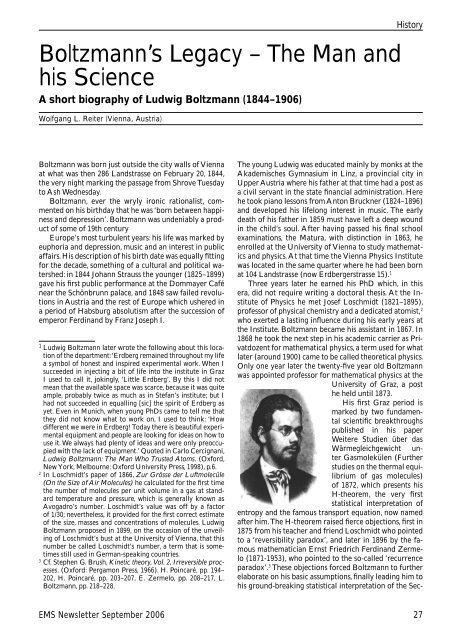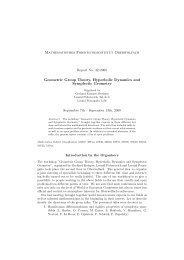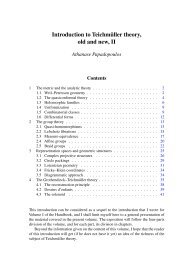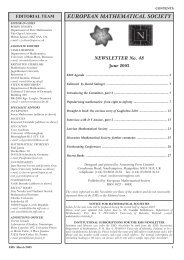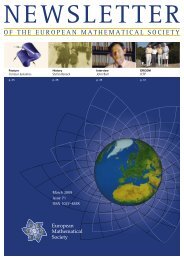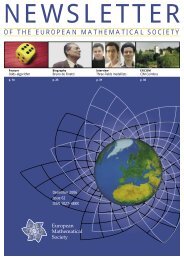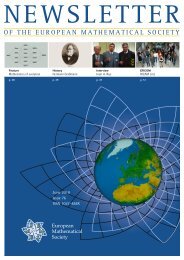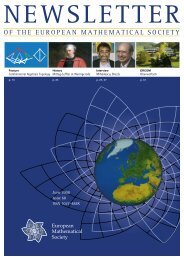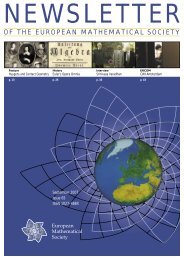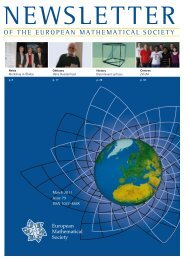OF THE EUROPEAN MATHEMATICAL SOCIETY
OF THE EUROPEAN MATHEMATICAL SOCIETY
OF THE EUROPEAN MATHEMATICAL SOCIETY
Create successful ePaper yourself
Turn your PDF publications into a flip-book with our unique Google optimized e-Paper software.
Boltzmann’s Legacy – The Man and<br />
his Science<br />
A short biography of Ludwig Boltzmann (1844–1906)<br />
Wolfgang L. Reiter (Vienna, Austria)<br />
Boltzmann was born just outside the city walls of Vienna<br />
at what was then 286 Landstrasse on February 20, 1844,<br />
the very night marking the passage from Shrove Tuesday<br />
to Ash Wednesday.<br />
Boltzmann, ever the wryly ironic rationalist, commented<br />
on his birthday that he was ‘born between happiness<br />
and depression’. Boltzmann was undeniably a product<br />
of some of 19th century<br />
Europe’s most turbulent years: his life was marked by<br />
euphoria and depression, music and an interest in public<br />
affairs. His description of his birth date was equally fi tting<br />
for the decade, something of a cultural and political watershed:<br />
in 1844 Johann Strauss the younger (1825–1899)<br />
gave his fi rst public performance at the Dommayer Café<br />
near the Schönbrunn palace, and 1848 saw failed revolutions<br />
in Austria and the rest of Europe which ushered in<br />
a period of Habsburg absolutism after the succession of<br />
emperor Ferdinand by Franz Joseph I.<br />
1 Ludwig Boltzmann later wrote the following about this location<br />
of the department: ‘Erdberg remained throughout my life<br />
a symbol of honest and inspired experimental work. When I<br />
succeeded in injecting a bit of life into the institute in Graz<br />
I used to call it, jokingly, ‘Little Erdberg’. By this I did not<br />
mean that the available space was scarce, because it was quite<br />
ample, probably twice as much as in Stefan’s institute; but I<br />
had not succeeded in equalling [sic] the spirit of Erdberg as<br />
yet. Even in Munich, when young PhDs came to tell me that<br />
they did not know what to work on, I used to think: ‘How<br />
different we were in Erdberg! Today there is beautiful experimental<br />
equipment and people are looking for ideas on how to<br />
use it. We always had plenty of ideas and were only preoccupied<br />
with the lack of equipment.’ Quoted in Carlo Cercignani,<br />
Ludwig Boltzmann: The Man Who Trusted Atoms. (Oxford,<br />
New York, Melbourne: Oxford University Press, 1998), p.6.<br />
2 In Loschmidt’s paper of 1866, Zur Grösse der Luftmolecüle<br />
(On the Size of Air Molecules) he calculated for the fi rst time<br />
the number of molecules per unit volume in a gas at standard<br />
temperature and pressure, which is generally known as<br />
Avogadro’s number. Loschmidt’s value was off by a factor<br />
of 1/30; nevertheless, it provided for the fi rst correct estimate<br />
of the size, masses and concentrations of molecules. Ludwig<br />
Boltzmann proposed in 1899, on the occasion of the unveiling<br />
of Loschmidt’s bust at the University of Vienna, that this<br />
number be called Loschmidt’s number, a term that is sometimes<br />
still used in German-speaking countries.<br />
3 Cf. Stephen G. Brush, Kinetic theory, Vol. 2, Irreversible processes.<br />
(Oxford: Pergamon Press, 1966). H. Poincaré, pp. 194–<br />
202, H. Poincaré, pp. 203–207, E. Zermelo, pp. 208–217, L.<br />
Boltzmann, pp. 218–228.<br />
History<br />
The young Ludwig was educated mainly by monks at the<br />
Akademisches Gymnasium in Linz, a provincial city in<br />
Upper Austria where his father at that time had a post as<br />
a civil servant in the state fi nancial administration. Here<br />
he took piano lessons from Anton Bruckner (1824–1896)<br />
and developed his lifelong interest in music. The early<br />
death of his father in 1859 must have left a deep wound<br />
in the child’s soul. After having passed his fi nal school<br />
examinations, the Matura, with distinction in 1863, he<br />
enrolled at the University of Vienna to study mathematics<br />
and physics. At that time the Vienna Physics Institute<br />
was located in the same quarter where he had been born<br />
at 104 Landstrasse (now Erdbergerstrasse 15). 1<br />
Three years later he earned his PhD which, in this<br />
era, did not require writing a doctoral thesis. At the Institute<br />
of Physics he met Josef Loschmidt (1821–1895),<br />
professor of physical chemistry and a dedicated atomist, 2<br />
who exerted a lasting infl uence during his early years at<br />
the Institute. Boltzmann became his assistant in 1867. In<br />
1868 he took the next step in his academic carrier as Privatdozent<br />
for mathematical physics, a term used for what<br />
later (around 1900) came to be called theoretical physics.<br />
Only one year later the twenty-fi ve year old Boltzmann<br />
was appointed professor for mathematical physics at the<br />
University of Graz, a post<br />
he held until 1873.<br />
His fi rst Graz period is<br />
marked by two fundamental<br />
scientifi c breakthroughs<br />
published in his paper<br />
Weitere Studien über das<br />
Wärmegleichgewicht unter<br />
Gasmolekülen (Further<br />
studies on the thermal equilibrium<br />
of gas molecules)<br />
of 1872, which presents his<br />
H-theorem, the very fi rst<br />
statistical interpretation of<br />
entropy and the famous transport equation, now named<br />
after him. The H-theorem raised fi erce objections, fi rst in<br />
1875 from his teacher and friend Loschmidt who pointed<br />
to a ‘reversibility paradox’, and later in 1896 by the famous<br />
mathematician Ernst Friedrich Ferdinand Zermelo<br />
(1871-1953), who pointed to the so-called ‘recurrence<br />
paradox’. 3 These objections forced Boltzmann to further<br />
elaborate on his basic assumptions, fi nally leading him to<br />
his ground-breaking statistical interpretation of the Sec-<br />
EMS Newsletter September 2006 27


